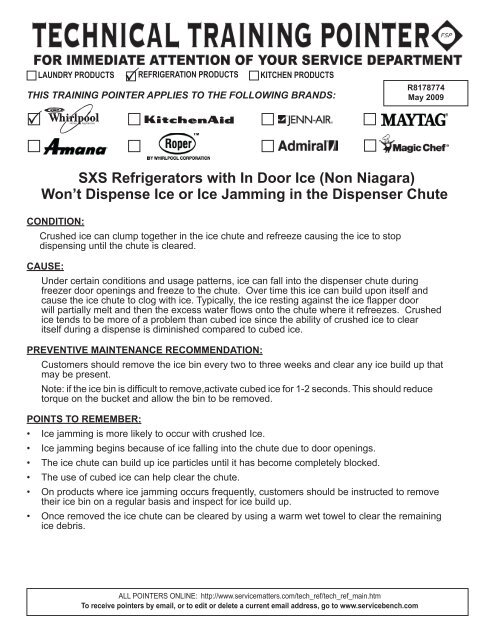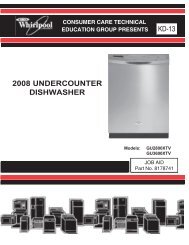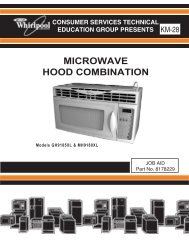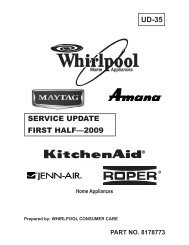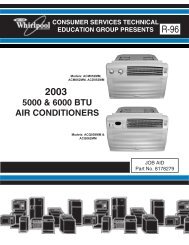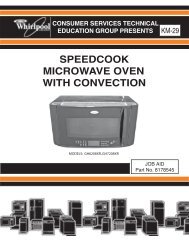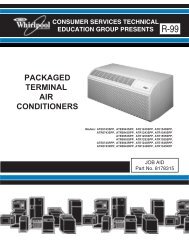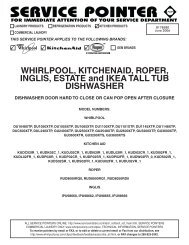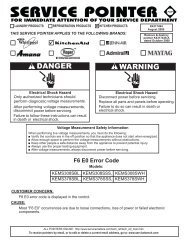sXs refrigerators with in door ice (non niagara)
sXs refrigerators with in door ice (non niagara)
sXs refrigerators with in door ice (non niagara)
You also want an ePaper? Increase the reach of your titles
YUMPU automatically turns print PDFs into web optimized ePapers that Google loves.
laundry Products<br />
refrigeration Products kitchen Products<br />
THIS TRAINING POINTER APPLIES TO THE FOLLOWING BRANDS:<br />
<br />
<br />
ALL POINTERS ONLINE: http://www.serv<strong>ice</strong>matters.com/tech_ref/tech_ref_ma<strong>in</strong>.htm<br />
to receive po<strong>in</strong>ters by email, or to edit or delete a current email address, go to www.serv<strong>ice</strong>bench.com<br />
r8178774<br />
May 2009<br />
<strong>sXs</strong> <strong>refrigerators</strong> <strong>with</strong> <strong>in</strong> <strong>door</strong> <strong>ice</strong> (<strong>non</strong> <strong>niagara</strong>)<br />
Won’t dispense <strong>ice</strong> or <strong>ice</strong> Jamm<strong>in</strong>g <strong>in</strong> the dispenser chute<br />
condition:<br />
Crushed <strong>ice</strong> can clump together <strong>in</strong> the <strong>ice</strong> chute and refreeze caus<strong>in</strong>g the <strong>ice</strong> to stop<br />
dispens<strong>in</strong>g until the chute is cleared.<br />
cause:<br />
Under certa<strong>in</strong> conditions and usage patterns, <strong>ice</strong> can fall <strong>in</strong>to the dispenser chute dur<strong>in</strong>g<br />
freezer <strong>door</strong> open<strong>in</strong>gs and freeze to the chute. Over time this <strong>ice</strong> can build upon itself and<br />
cause the <strong>ice</strong> chute to clog <strong>with</strong> <strong>ice</strong>. Typically, the <strong>ice</strong> rest<strong>in</strong>g aga<strong>in</strong>st the <strong>ice</strong> flapper <strong>door</strong><br />
will partially melt and then the excess water flows onto the chute where it refreezes. Crushed<br />
<strong>ice</strong> tends to be more of a problem than cubed <strong>ice</strong> s<strong>in</strong>ce the ability of crushed <strong>ice</strong> to clear<br />
itself dur<strong>in</strong>g a dispense is dim<strong>in</strong>ished compared to cubed <strong>ice</strong>.<br />
PreVentiVe Ma<strong>in</strong>tenance recoMMendation:<br />
Customers should remove the <strong>ice</strong> b<strong>in</strong> every two to three weeks and clear any <strong>ice</strong> build up that<br />
may be present.<br />
Note: if the <strong>ice</strong> b<strong>in</strong> is difficult to remove,activate cubed <strong>ice</strong> for 1-2 seconds. This should reduce<br />
torque on the bucket and allow the b<strong>in</strong> to be removed.<br />
Po<strong>in</strong>ts to reMeMBer:<br />
•<br />
•<br />
•<br />
•<br />
•<br />
•<br />
Ice jamm<strong>in</strong>g is more likely to occur <strong>with</strong> crushed Ice.<br />
Ice jamm<strong>in</strong>g beg<strong>in</strong>s because of <strong>ice</strong> fall<strong>in</strong>g <strong>in</strong>to the chute due to <strong>door</strong> open<strong>in</strong>gs.<br />
The <strong>ice</strong> chute can build up <strong>ice</strong> particles until it has become completely blocked.<br />
The use of cubed <strong>ice</strong> can help clear the chute.<br />
On products where <strong>ice</strong> jamm<strong>in</strong>g occurs frequently, customers should be <strong>in</strong>structed to remove<br />
their <strong>ice</strong> b<strong>in</strong> on a regular basis and <strong>in</strong>spect for <strong>ice</strong> build up.<br />
Once removed the <strong>ice</strong> chute can be cleared by us<strong>in</strong>g a warm wet towel to clear the rema<strong>in</strong><strong>in</strong>g<br />
<strong>ice</strong> debris.
Productos de laVanderÍa<br />
<br />
Productos de refrigeraciÓn Productos de coc<strong>in</strong>a<br />
ESTE BOLETIN DE SERVICIO SE APLICA A LAS SIGUIENTES MARCAS<br />
<br />
r8178774<br />
Mayo 2009<br />
refrigeradores de dos puertas con fábrica de hielo en la puerta<br />
(no se <strong>in</strong>cluye <strong>niagara</strong>) no despacha hielo o el hielo queda<br />
trabado en el conducto de despachado<br />
condiciÓn:<br />
Es posible que el hielo triturado se aglut<strong>in</strong>e en el conducto de hielo y vuelva a congelarse, lo<br />
que hará que deje de despacharse hielo hasta que se despeje el conducto.<br />
causa:<br />
Bajo ciertas condiciones y patrones de uso, es posible que el hielo caiga en el conducto de<br />
despachado cuando se abre la puerta del congelador y se congele en el conducto. Con el paso<br />
del tiempo, este hielo puede acumularse y hacer que se obstruya con hielo el conducto de hielo.<br />
En general, el hielo que queda contra la aleta de la puerta de hielo se derrite parcialmente y el<br />
exceso de agua fluye en el conducto, en donde vuelve a congelarse. El hielo triturado tiende<br />
a ocasionar más problemas que el hielo en cubos, ya que la capacidad del hielo triturado para<br />
despejarse durante el despacho es menor comparada con la del hielo en cubos.<br />
recoMendaciÓn de ManteniMiento PreVentiVo:<br />
El cliente deberá remover el depósito de hielo cada dos o tres semanas y limpiar la<br />
acumulación de hielo que pueda haberse formado.<br />
Nota: Si es difícil remover el depósito de hielo, active la característica de hielo en cubos<br />
durante 1 a 2 segundos. Esto deberá reducir la torsión en el balde y permitir que se quite el<br />
depósito.<br />
Puntos a tener en cuenta:<br />
• Es más probable que se aglut<strong>in</strong>e hielo cuando se usa hielo triturado.<br />
• El aglut<strong>in</strong>amiento de hielo comienza porque el hielo cae en el conducto debido a las veces<br />
que se abre la puerta.<br />
• El conducto de hielo puede acumular partículas de hielo hasta bloquearse por completo.<br />
• El uso de hielo en cubos puede ayudar a que se despeje el conducto.<br />
• En los productos en los cuales ocurre un aglut<strong>in</strong>amiento de hielo con frecuencia, se deberá<br />
<strong>in</strong>dicar a los clientes que quiten el depósito de hielo periódicamente y que <strong>in</strong>speccionen para<br />
ver si se ha acumulado el hielo.<br />
•<br />
TODOS LOS BOLETINES EN LÍNEA: http://www.serv<strong>ice</strong>matters.com/tech_ref/tech_ref_ma<strong>in</strong>.htm<br />
Para recibir bolet<strong>in</strong>es por correo electrónico, o para corregir o elim<strong>in</strong>ar una dirección de correo electrónico actual, visite: www.serv<strong>ice</strong>bench.com<br />
.


